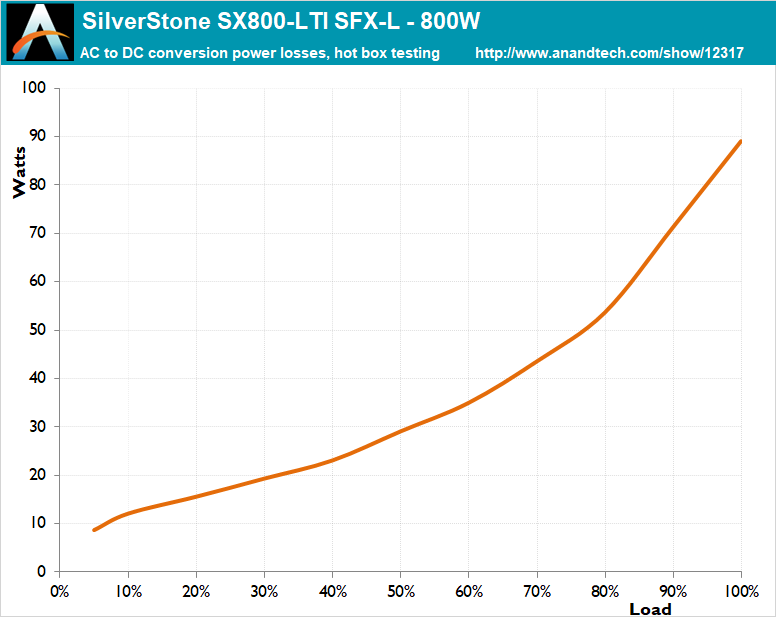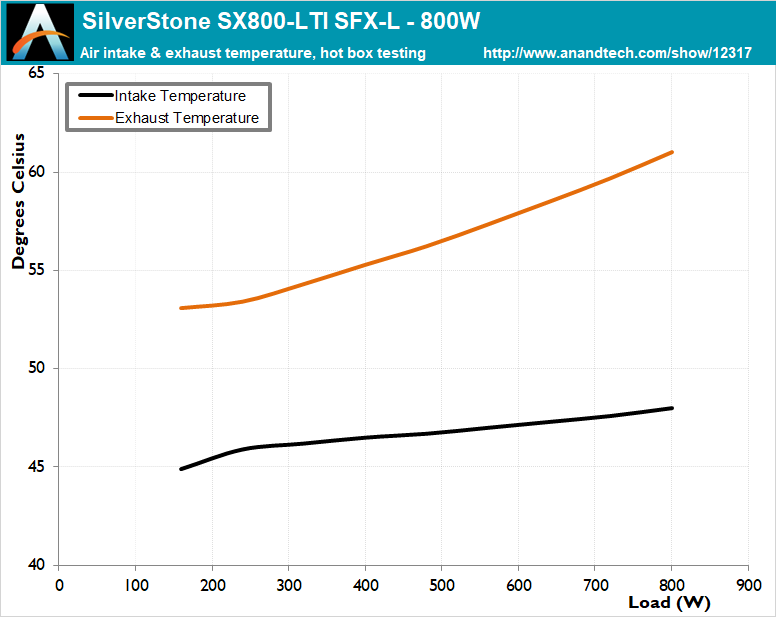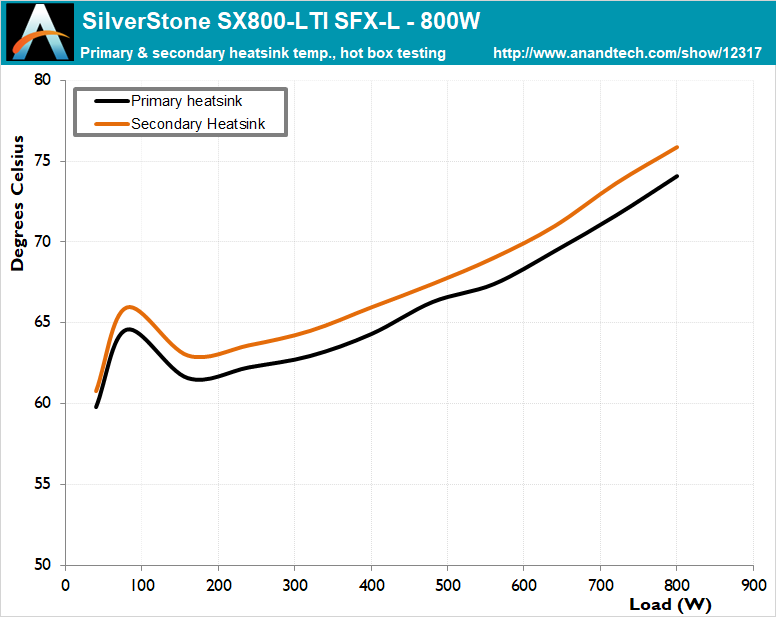The SilverStone SX800-LTI SFX-L 800W PSU Review: Big PSU, Small Niche
by E. Fylladitakis on January 18, 2018 9:00 AM EST- Posted in
- Cases/Cooling/PSUs
- SilverStone
- SFX
- SFX-L
Hot Test Results
The electrical performance of the SilverStone SX800-LTI is not greatly improved over that of the slightly older SilverStone SX700-LPT, but there is a small improvement on the output power quality. Voltage ripple figures are adequate, with our instruments recording a maximum of 36 mV, 40 mV and 32 mV on the 12V, 5V and 3.3V lines respectively. The paradox here is that the main 12V line seems to be much better filtered than the minor 5V/3.3V lines, which seem to have been somewhat neglected, perhaps because the designer just could not find enough space for more filtering components. Voltage regulation is good, with the 12V line maintaining a regulation of 2.2%. The 3.3V/5V lines are falling slightly behind, with the regulation at about 2.4%.
| Main Output | ||||||||
| Load (Watts) | 162.8 W | 404.87 W | 603.21 W | 796.4 W | ||||
| Load (Percent) | 20.35% | 50.61% | 75.4% | 99.55% | ||||
| Amperes | Volts | Amperes | Volts | Amperes | Volts | Amperes | Volts | |
| 3.3 V | 1.5 | 3.41 | 3.74 | 3.39 | 5.61 | 3.34 | 7.48 | 3.33 |
| 5 V | 1.4 | 5.1 | 3.51 | 5.07 | 5.26 | 5.03 | 7.01 | 4.98 |
| 12 V | 12.34 | 12.2 | 30.84 | 12.14 | 46.27 | 12.06 | 61.69 | 11.94 |
| Line | Regulation (20% to 100% load) |
Voltage Ripple (mV) | |||||
| 20% Load | 50% Load | 75% Load | 100% Load | CL1 12V |
CL2 3.3V + 5V |
||
| 3.3V | 2.6% | 22 | 24 | 26 | 32 | 16 | 26 |
| 5V | 2.4% | 20 | 30 | 32 | 40 | 18 | 26 |
| 12V | 2.2% | 16 | 22 | 30 | 36 | 36 | 22 |
Although the SX800-LTI is rated for operation up to 40°C, the unit had little trouble operating inside our hotbox. Naturally, the energy conversion efficiency took a measurable hit and the average efficiency across the nominal load range dropped down to 91.6%. The reduction of the unit’s efficiency is somewhat greater at higher loads, suggesting that the active components are slightly stressed by the high ambient temperatures.
The internal temperatures of the SX800-LTI, while it was operating in our hotbox, were surprisingly low. PSUs usually reach temperatures exceeding 80°C under these operating conditions, but the SilverStone SX800-LTI hardly reached up to 75°C under maximum load. This time the cooling fan started even sooner, when a load just higher than 120 Watts. The thermal control of this unit is very aggressive, probably because SilverStone did not want to risk reducing its reliability over better acoustics performance.
Under these high temperature conditions, the cooling fan of the SX800-LTI not only starts sooner but also immediately increases its speed to audible levels. Inside the hot box, the PSU is louder with a load of just 200 Watts than with a load of 550 Watts in room temperature. As the load increases, the speed of the fan constantly increases as well, reaching its maximum possible speed when the load exceeds 700 Watts. Thankfully our hotbox test is one of extremes and that - outside of poorly ventilated cabinets - few home users have environments this warm, as the sound pressure levels with a load above 500 Watts under these conditions would be practically intolerable for home users.















25 Comments
View All Comments
Meaker10 - Friday, January 19, 2018 - link
It can help room temperatures and with a small forn factor case it could make a difference to internal temperatures.sonny73n - Friday, January 19, 2018 - link
@meaker10Huh? PSU & temperatures? What?!
DanNeely - Friday, January 19, 2018 - link
All the power lost due to PSU inefficiency is extra heat added to the room. When it's cold it works like supplemental furnace/etc (if electric heat is cost effective depends on what the other heat source is); in the summer it's just more heat for the AC to push out of the building.meacupla - Saturday, January 20, 2018 - link
But if a 600W PSU is pulling 90% efficiency at 400W, where as this 800W PSU is pulling 94% efficiency at 400W, the 600W would be consuming 444W, versus the 800W would be consuming 425W.A 19W difference is hardly going to result in a noticeable difference inside the case, since PSUs only expel heat.
Macpoedel - Tuesday, January 23, 2018 - link
According to Silverstone's charts the 500W SFX-L PSU is 91% efficient at a 400W load (with a 230V AC input voltage), this 800W PSU is 95 % efficient at the same load. That comes down to 439W and 421W from the wall, let's take 20W for simplicity.If the PC were to have a continuous load of 400W all year long, that makes 175.2 kWh. In my country electricity is pretty expensive, around 0.21€/kWh (probably a bit more now, 0.21 was a few years ago).
175.2 kWh would then cost €36.7, but the price difference between the 500W and 800W variant is around €100, so you'd need about 3 years of continous load at 50% to benefit from the better efficiency.
Let's also assume this PSU isn't powering a mining rig but a workstation, that gets used around 8 hours a day, that makes 9 years before the higher efficiency pays off. I doubt many PSU's are used for longer than that.
Also, in most cases a 400W continuous load is a very unrealistic assumption, most pc's idle most of the time, even workstations (and this is not a server PSU). Below 20% load, both PSU's have pretty much the same efficiency.
So when exactly does the higher efficiency pay off for pc's that don't have a continuous load? Pretty much never...
Much more important are the warranty and component quality, and it's not like the 800W PSU is so much better in those regards, it's not going to last longer, the chances of failure are the same.
I'd even argue in favor of a 80Plus Bronze PSU instead of 80Plus Gold, because those gains in efficiency are very slim as well, but then component quality often is a bit worse and the warranty period goes down to 3 years or lower, so paying more for better quality makes sense there (for the same capacity!)
Now if you want your workstation to consume as little power as possible, be my guest and pay double the price for a PSU that only has to deliver half of its capacity at most, just don't expect the investment to pay off.
Macpoedel - Tuesday, January 23, 2018 - link
Oh when I say 175.2 kWh, I'm talking about that 20W power difference between 91 and 94% efficiency, not total consumption, that would cost a lot more than €36 of course.Foeketijn - Friday, January 19, 2018 - link
I think it would be more likely be, because it is far more easy to get the titanium certification on a high powered psu. There is a reason why there are no affordable high efficiency low powerd psu's.The Benjamins - Thursday, January 18, 2018 - link
It only having 1 4+4 EPS sucks, you can't use this for the AsRock X399M board in a CaseLabs Bullet BH4.PeachNCream - Thursday, January 18, 2018 - link
The article's title is like a perfect TL;DR summary. As far as SFX goes, it's a small niche product. I can't think of too many system builds that would require that much power output inside a small enough case, that also supports the larger-than-SFX physical dimensions.Lau_Tech - Thursday, January 18, 2018 - link
These "stuff i found in my attic" reviews are really blockbuster stuff, eh?